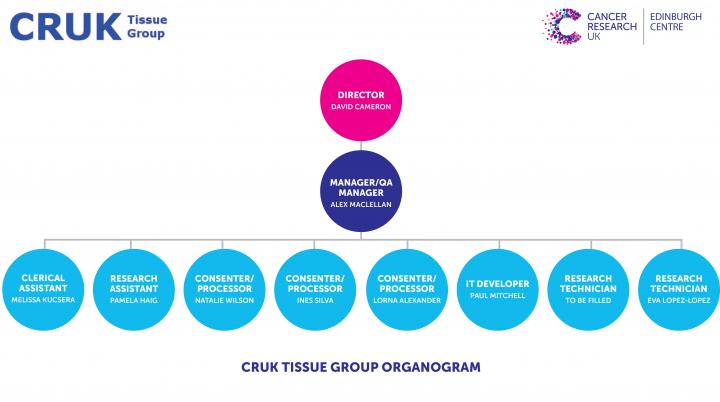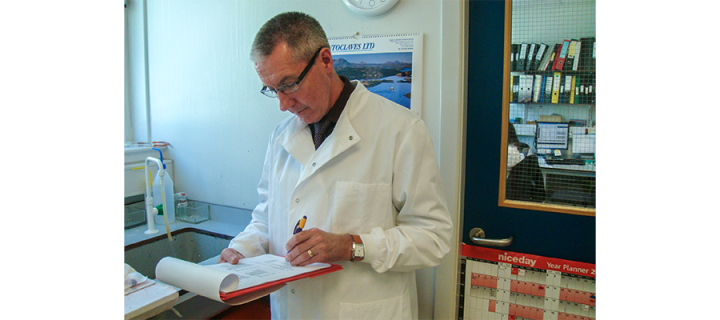Edinburgh CRUK Tissue Group
Tissue collection and biobanking for the research and development of novel cancer treatments and interventions.
Due to a change in funding stream from 01/04/2017, the Edinburgh Experimental Cancer Medicine Centre (ECMC) team are now known as the Edinburgh CRUK Tissue Group (CRUKTG). The CRUKTG is now part of the Cancer Research UK funded Edinburgh Cancer Research Centre. The CRUKTG aims to build on and extend the foundations of the ECMC, which has established a team to systematically ascertain, counsel and recruit patients with the aim of enhancing translational research and appropriately collect biological materials and clinical data pertaining to these samples.
The CRUKTG brings together scientific and clinical research, sharing knowledge and resources for the benefit of cancer patients. It facilitates the translational research needed to develop new anti-cancer drugs, supports discovery and validation of new diagnostic, prognostic and predictive markers and drug-target discovery. The CRUKTG provides generic support for focussed, mechanistic clinical trials, enabling translational research from the laboratory to the clinic.

COLLECTION OF SAMPLES: CRUK TISSUE GROUP GUIDELINES

PATIENTS
Patients with either known or suspected cancer are identified by surgeons or trained members of staff as being suitable for tissue collection. These patients are approached, given a patient information sheet to read and have the opportunity to ask questions. If they want to continue they will sign the consent form for specimens being taken and used for research.
PROCEDURES
The CRUK Tissue Group performs work in compliance with Good Clinical Practice (GCP) and Good Clinical Laboratory Practice (GCLP). All procedures and processes undertaken by the CRUKTG are covered by standard operating procedures (SOPs). These are controlled documents which detail how to perform routine tasks or activities. They ensure procedures are performed consistently by all staff.
ACQUISITION
Specimens are collected directly from theatre or wards along with the signed consent form. Ideally all specimens will be collected and either stored or processed within 1 hour of being removed from the patient. The patient details and sample information are recorded on a standard form which allows the CRUKTG to obtain clinical information to link to the sample.
All the specimens are given a unique ID therefore making the samples anonymous so that the researcher using the specimens does not know the patients details.
PROCESSING
The specimens can be processed in a variety of ways. Tissue samples from theatre can either be frozen and stored in liquid nitrogen or fixed in formalin and processed into formalin fixed paraffin embedded (FFPE) blocks.
Blood and fluid samples can be stored whole or processed to isolate specific cell types or components within the sample i.e. lymphocytes in a blood sample.
STORAGE
Fresh Tissue specimens are routinely stored in liquid nitrogen. This process known as Cryopreservation, stores the specimens at low sub-zero temperatures, −196 °C (the boiling point of liquid nitrogen). At this low temperature, any biological activity, including the biochemical reactions that would lead to cell death, are effectively stopped, therefore preserving the tissue in the same state as it was sampled.
FFPE blocks can be stored at room temperature.
The sample storage position is recorded on an electronic database (CA Tissue Suite).
The CRUKTG does not store/release any tissue for research if a signed consent form is not present.
DISTRIBUTION
The CRUKTG will supply specimens to researchers who request them as long as they have ethical approval for the work they will be performing. All specimens have a unique ID and the researcher will never know the identity of the patient. The CRUKTG will transport samples in the condition they are stored in for example frozen tissue will be transported on dry ice to maintain the sub-zero temperature. All samples are appropriately packaged with the relevant warnings, are accompanied with a sample inventory and if required the relevant clinical data linked to the sample.
ANALYSIS
There are many different types of analysis that can be performed on specimens and this is dependent on what is being researched. For example fresh-frozen tissue samples can be used for DNA/RNA and protein extraction.
FFPE blocks can be cut into thin sections, placed on a slide and stained to identify different parts of the tissue and cells. Sections can also be taken and used for DNA extraction and immunohistochemisrty. In addition FFPE blocks can be used to create a Tissue Micro-Array which allows the researcher to compare up to 250 different cases (i.e. compare 250 tumour samples from 250 different patients) on one slide.
RESTOCKING
The continued consenting of new patients means that new samples are collected every week, increasing the number of samples stored in our tissue bank ensuring that enough samples are available to perform the essential research.

